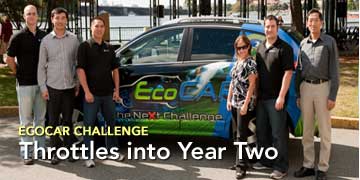EcoCAR Challenge Throttles into Year Two
September 30, 2009

Seventeen university teams are heading into the next stageof the three-year EcoCAR: the NeXtChallenge automotive engineering competition, convening in Boston this weekfor additional training designed to prepare them for the validation and testingwork that comes with year two.
The competition, established by the United States Dept. of Energy (DOE) and General Motors and managed by the Argonne National Lab., challenges universityteams in North America to reduce the environmental impact of vehicles whileretaining performance and safety standards and without sacrificing consumerappeal. The teams are charged with reengineering a donated 2009 Saturn Vue toexplore advanced propulsion and clean vehicle solutions, includingfull-function electric, range-extended electric, hybrid, plug-in hybrid andfuel cell technologies. The students have to comply with real-world engineeringprocesses to design and integrate their advanced technology designs and theyare also working to incorporate lightweight materials to improve aerodynamicsand to utilize alternative fuels such as ethanol, biodiesel and hydrogen.
Rather than being a forum to generate production-ready new,alternative vehicle technologies, the EcoCAR challenge is really aboutfostering a breeding ground for up and coming engineers, introducing them tokey technologies and indoctrinating them in real-world design processes. "Whilethe technologies that go into the vehicles are definitely cutting edge, we don'tthink one of these vehicles is going to change the world or outperform GM,"says Mike Walstrum, control and simulation engineer at the Argonne NationalLab. "We're trying to acclimate students to the real-world environment. Ourgoal is to develop engineers of the future who can really hit the groundrunning and start their careers off by developing environmentally friendlyautomotive applications."
To that end, the teams are settling into year two of thecompetition, focused on the testing and validation stage of their designs.While model-Based Design tools such as SimuLink from The MathWorks and others from National Instruments were used the first year tocreate the engine components, the tools will now play a role in optimizing andtesting the design parameters and the control software prior to the build stagewhere the teams create near-production-ready components. Model-Based Design isimportant to the competition — and design teams, in general — because it allowsengineers to test a variety of scenarios quickly before launching into the morecostly and time-consuming physical implementation.
"Engineers are good at experimenting with things and tryingdifferent configurations, and model-based methods provide a safe playgroundwhere they can investigate different configurations," says Paul Smith, directorof consulting services at The MathWorks. Because real-world automotivesuppliers like GM apply model-Based Design in their design processes, exposingup-and-coming engineers to the discipline and the available tools is criticalto their training, Smith says.
For Jeremy Wise, team leader for the University ofVictoria's EcoCAR team, learning to embrace model-Based Design has been theultimate learning experience of the challenge. "At first, I didn't like it," hesays, "because you had to do work before you got to play with the engines andmotors. I just wanted to get my hands dirty working on the cars. This has givenme a taste of the real world."
About the Author(s)
You May Also Like



.jpg?width=300&auto=webp&quality=80&disable=upscale)

